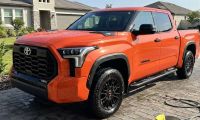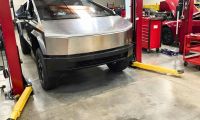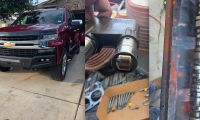The Mazda CX-30 two-row crossover is fun enough. We love driving it. It’s certainly good looking enough. It’s easily the best in class design. And it’s got the goodies we come to expect in a Mazda. There is only one real question left; Is it big enough?
Related Story - Is the Hyundai Kona Crossover Big Enough?
That is a question only you can answer for yourself, However, we can help you with facts, figures, and our own testing impressions of the CX-30s size. That top of page image may be worth 1,000 words. Before you judge the CX-30 strictly on that alone, let us tell you that we didn’t edit the photo to make the CX-30 look smaller or the CX-5 look larger. It is the perspective of the photo that gives the impression that the CX-30 is dramatically smaller. It really isn’t.

We have just tested the CX-30 and found it to be very similar in almost every way to the CX-5 which resides in the segment above it. The CX-5 is the same size more or less as the Honda CR-V and Toyota RAV4. Both of those crossovers are top sellers overall in the US market, second only to a pair of pickup truck models. The CX-5 is obviously big enough for most families or individuals, which is why it is Mazda’s top-selling vehicle overall.
Coincidental to this story, our family owns a CX-5 and we find that it is the perfect vehicle for families with two children. The CX-5 is very fuel efficient, and the CX-30 only gets 1 MPG more overall in fuel economy, barely any advantage. The two vehicles have overlapping price points as well. The top-trim CX-30 we tested had a sticker price of about $32K and a similarly-equipped CX-5 would cost a buyer $33K. It is hard to argue in favor of the CX-30 based on any fuel or cost savings versus its bigger sibling. But how much bigger is the CX-5 really?
Let’s consider some hard facts first and then we will tell you what it’s like when used with passengers and road trip cargo. Let’s start with a comparison showing the space-related specifications and dimensions of the Mazda CX-30 in comparison to the CX-5.
Length - 173 inches - CX-30 six inches shorter than CX-5
Width - 70.7 inches - About two inches narrower than CX-5
Height - 62 inches - About four inches shorter than CX-5
As you can see, the CX-30 is smaller than the CX-5 in all regards. But how does that translate into useable space? The passenger volume of the CX-30 is 94 cubic feet. The CX-5 is ten cubic feet greater in total volume.

The CX-30 has 20 cubic feet of cargo space behind its rear seats and 45 cu ft with them folded. The CX-5 has 31 cu ft and 57 cu ft by comparison.

We have now provided the cold hard facts, but what does the CX-30 feel like in comparison to the CX-5? Very similar in many ways. Really, there is one major difference. That is back seat space. We find the CX-5 can accommodate two adult passengers in the rear comfortably on long trips and the CX-30 is better suited to carrying two children under four and a half feet in height on long trips comfortably.

Yes, the cargo space also is a difference worthy of consideration, but its not night and day different in actual practice.

One way the CX-30 makes up for some of the lost space is by making the front seat area very roomy for the drive and passenger. In fact, the center console of the CX-30 is very large and more useful than our CX-5’s. It is both larger in its dimensions to our eye and it is more cleverly designed. One other plus for the CX-30 space-wise is that if you are a tall driver, you will find ample right-knee space. Many crossovers (CX-5 included) make the mistake of crowding that spot with the bottom of the center stack. The CX-30 gives taller drivers more room for their legs than does its larger sibling.
The CX-30 and CX-5 share almost all of their drivetrain components and have very similar features. The only question is why buy the CX-30 if the total cost of ownership is nearly identical to the CX-5? Only a buyer can answer that question, but we have two thoughts on that.

First is looks. Both are the best-looking in their classes, but the CX-30 is sleeker and lower. We find it the more attractively styled of the pair. Second, perceived space. Some owners who live in urban areas are more comfortable in a smaller vehicle.
The Mazda CX-30 is fun to drive, a top safety pick, and affordable. It is a crossover with fantastic styling and features. Drivers who are considering the Hyundai Kona, Subaru Crosstrek, and Kia Steltos would be wise to add the CX-30 to their shortlist for consideration.
John Goreham is a long-time New England Motor Press Association member and recovering engineer. John's focus areas are technology, safety, and green vehicles. In the 1990s, he was part of a team that built a solar-electric vehicle from scratch. His was the role of battery thermal control designer. For 20 years he applied his engineering and sales talents in the high tech world and published numerous articles in technical journals such as Chemical Processing Magazine. In 2008 he retired from that career to chase his dream of being an auto writer. In addition to Torque News, John's work has appeared in print in dozens of American newspapers and he provides reviews to many vehicle shopping sites. You can follow John on Twitter, and view his credentials at Linkedin
Hover mouse over image to see photo credits.












Comments
The nose is.
Permalink
The nose is.
True LOL! :)
Permalink
In reply to The nose is. by Mark (not verified)
True LOL! :)
Both sweet looking. I think I
Permalink
Both sweet looking. I think I would opt for the CX-5.
Should also compare to the CX
Permalink
Should also compare to the CX-3.
The only reason that I bought
Permalink
The only reason that I bought a cx5 instead of a cx30 is that a set of golf clubs do not fit in the back of the cx30. It is only a few inches narrower but it made the difference.
Yes I know that I could have folded a back seat but my clubs live in the car for six months of the year.